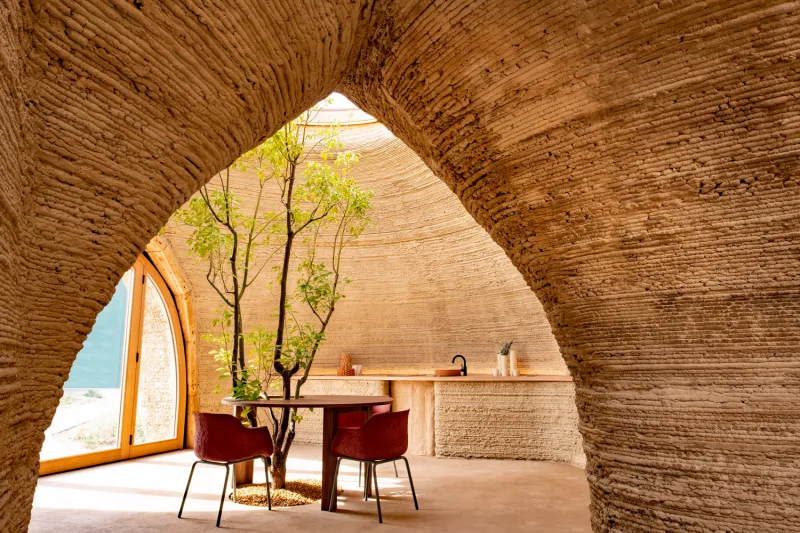Share This Article
- Sustainable Design Principles
- Energy-Efficient Technologies
- Adaptive Reuse and Renovation
- Green Building Materials
- Climate-Resilient Architecture
- Achieving Net-Zero Energy Buildings
- In short
Sustainability is no longer a badge of honour but a necessity of the hour. The construction industry is responsible for 37% of global emissions. This uniquely positions architects to drive change through responsible design practices. Architects can mitigate the climate crisis by incorporating sustainable design, energy efficiency and green building design. Let’s explore actionable strategies architects can use to combat climate change and create a better tomorrow.
Sustainable Design Principles
Since sustainability is a term thrown around casually, it’s important to define it first. Sustainability is the use of less ?sustainable architecture is the use of fewer resources, less material and less energy throughout the life cycle of the building, from its construction to its use and maintenance. Designing structures to use fewer resources, materials and energy in the long run is a healthy practice.
Passive solar design lets you heat/cool the space with limited mechanical input. Angling the roof and shade, using heat-absorbent materials and positioning windows to allow for effective circulation can help adjust temperature passively.

Building orientation can make or break your sustainability efforts. A rectangular form with short sides at the East and West limits harsh sunlight. These sides can be covered with vegetation for better protection. The building can be slightly oriented to permit prevailing winds to pass through the space. All of this reduces the need for active cooling devices.
The Eastgate building in Harare uses passive cooling and materials with high thermal capacity to make the most of its environment. Inspired by termite mounds, the building is one giant system of air tunnels channelling air from its base to its head with little external input.

Energy-Efficient Technologies
Technological advancements help us reduce energy consumption through specific materials or systems. LED lights significantly reduce electricity usage while providing superior lighting quality. ?Smart building automation with energy-efficient HVAC systems can optimise energy use based on the environment and occupancy. This helps prevent energy wastage and can reduce energy loads significantly in the long run.
Creative cooling innovations can help you save up on energy bills and keep the planet happy. Delhi-based Ant Studio has devised an evaporative cooling terracotta tunnel CoolAnt that keeps you cool with just some water running over it. It uses zero electricity and works on evaporative cooling. While traditional ACs heat the exterior to keep the interiors warm, CoolAnt relies on simple physics to keep you and the earth cool.

Adaptive Reuse and Renovation
Adaptive reuse embodies the spirit of sustainability, with its ability to breathe life into existing structures while minimising the use of resources. It involves retrofitting a building with new systems and adding spaces as extensions, preserving the original as much as possible. This has the added benefit of preserving the culture and stories behind the structure, offering the best of both worlds.

Imagine Studio at the Trees by Studio Lotus is an adaptive reuse project in Mumbai for Godrej Properties Ltd, one of India?s industrial giants. By converting Godrej?s industrial campus rich with history into an Experience Centre for their flagship development ?The Trees?, Studio Lotus has given a second life to these spaces without erasing the history behind the site and its structures.
Green Building Materials
Life Cycle Assessment (LCA) of materials evaluate the environmental impact of building materials from procurement to disposal, enabling informed decision-making and sustainable practices. Using eco-friendly building materials like reclaimed wood, low-emission paint, recycled concrete and bamboo are preferred, along with vernacular materials because they are locally available and use little energy to obtain.

By 3D printing using raw earth, Mario Cucinella Architects has shown that sustainability can be realised better through technology. This nearly zero-emission project using vernacular materials reduced wastage and is a beautiful example of low-carbon construction.
Climate-Resilient Architecture
Intensifying climate change calls for buildings that can withstand the calamities that they?re likely to face. Climate resilient architecture emphasizes preparedness, durability and adaptability in the face of floods, hurricanes, heatwaves and other climate hazards. The design approach depends on the specific climatic issues the place can face. For instance, elevated foundations keep structures safe in flood-prone areas. Reinforced concrete structures with hurricane-resistant windows are optimal in hurricane-prone regions. To combat heatwaves, green spaces, water bodies and optimal ventilation can be useful.

After the 2018 floods in Kerala, flood-resistant houses began to make an appearance. The structures built on 8m tall columns are also designed to withstand earthquakes of up to the magnitude of 7 on the Richter scale.
Achieving Net-Zero Energy Buildings
A Net-Zero Energy Building (NZEB) is one where the total amount of energy used by the building is matched by the amount of energy created on site. Through the use of passive design and renewable energy sources, architects can create NZEBs that reduce dependency on fossil fuels and as a result, carbon emissions too.

The Bullitt Centre in Seattle is a net-zero energy building that utilises rainwater collection, aerobic composters and rooftop photovoltaic panels that produce 230,000 kilowatt-hours annually.
In short
With great power comes great responsibility, and when it comes to fighting the climate crisis, architects are pretty powerful. To shoulder this responsibility, architects are armed with sustainable modes of construction, green building materials and energy-efficient technology.
It?s about time sustainability graduates from a marketing tactic to an indispensable mode of design.
Sources:
- https://www.unep.org/resources/report/building-materials-and-climate-constructing-new-future
https://sustainability.williams.edu/green-building-basics/passive-solar-design/ - https://nzeb.in/knowledge-centre/passive-design/form- orientation/#:~:text=A%20rectangular%20form%20with%20a,spaces%2C%20shaded%20walls%2C%20etc
- https://asknature.org/innovation/passively-cooled-building-inspired-by-termite-mounds/
- https://authindia.com/coolant-zero-energy-air-conditioner-a-terracotta-air-conditioner-designed-by-ant-studio/
- https://www.youtube.com/watch?v=fhXJ_1Qiou4
- https://www.archdaily.com/916722/imagine-studio-at-the-trees-studio-lotus-plus-gpl-design-studio
- https://www.archdaily.com/960714/tecla-technology-and-clay-3d-printed-house-mario-cucinella-architects
- https://www.preventionweb.net/news/5-ways-make-buildings-climate-change-resilient
- https://www.newsclick.in/Lessons-2018-Floods-Flood-resistant-Houses-Kerala-Forward
- https://www.archdaily.com/363007/the-world-s-greenest-commercial-building-opens-in-seattle-today
- https://www.novatr.com/blog/what-are-net-zero-buildings#:~:text=The%20Bullitt%20Center%20in%20Seattle,windows%20and%20super-insulated%20walls.

